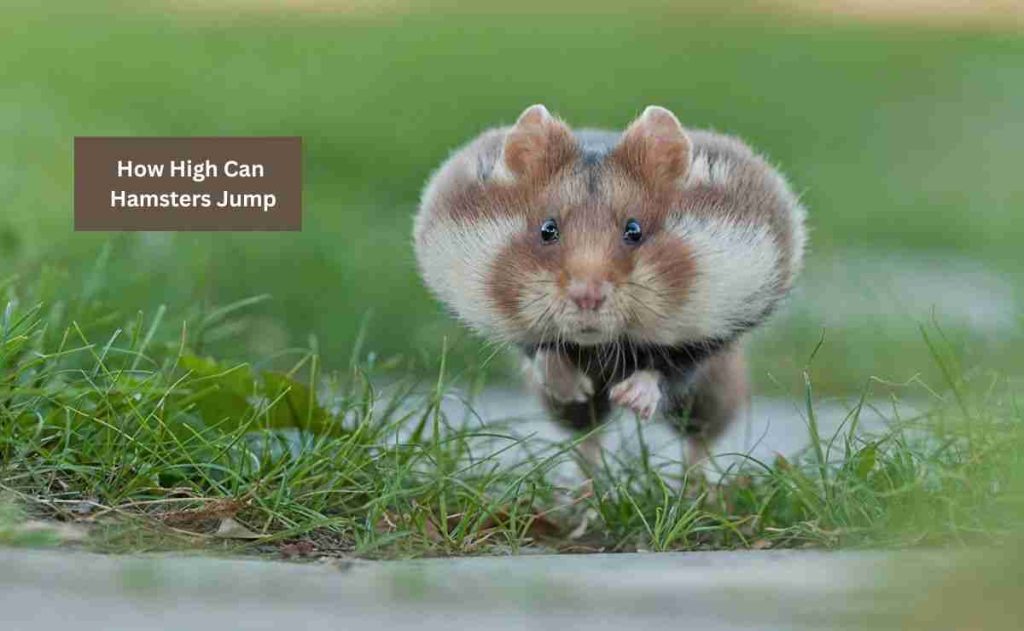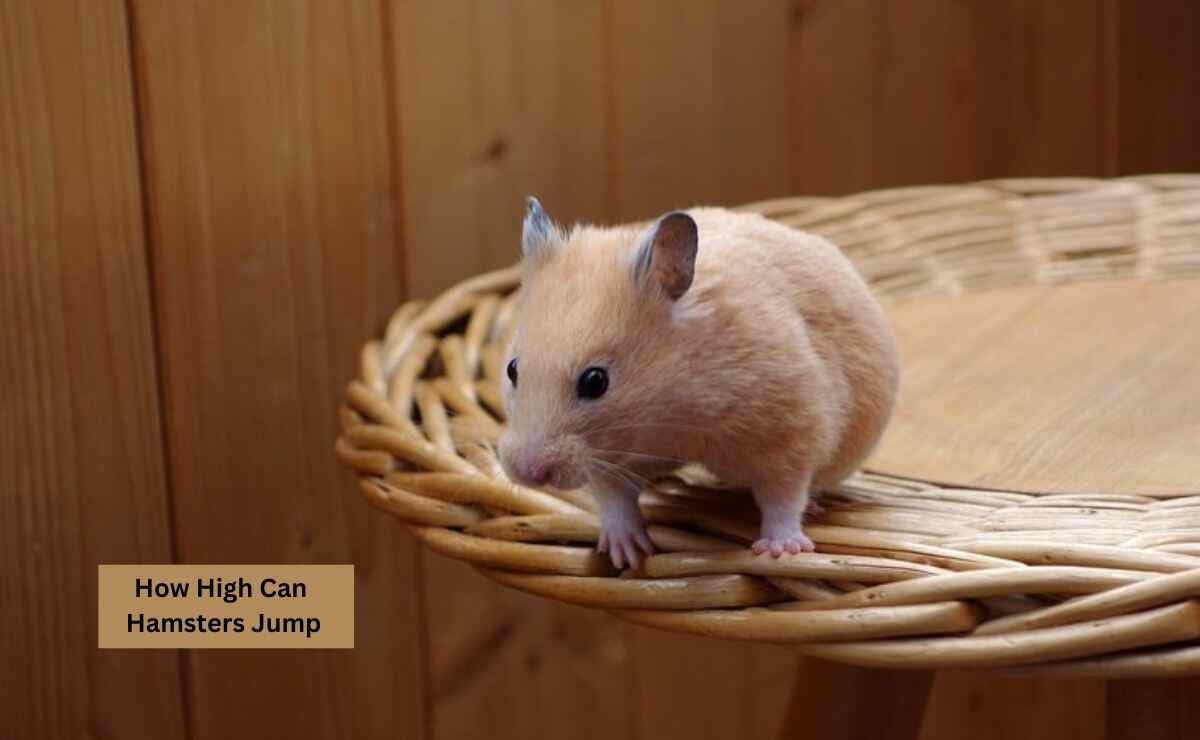It’s a matter of wonder that such small creatures like hamsters are so energetic and joyful. Therefore, many hamsters love to jump all around their cage to explore the surroundings.
Also, their jumping game continues when they are outside of the cage. So, you have to be aware of how high can hamsters jump to ensure a safe territory. It is important to know to prevent falls and elevate the level of safety. Here you can find out all the details about their jumping abilities.
How high can hamsters jump?

The height a hamster can jump varies. It depends on their breed and size. Typically, they can jump in the range of 8 to 15 inches from the base of their cage. However, some hamsters jump at heights slightly lower than this range due to differences in their foot structure and particular characteristics.
Dwarf hamsters are usually smaller in size and with less powerful leg muscles. They can jump below 10 inches. Their diminutive stature restricts their jumping capabilities. Still, their jumps are impressive compared to their size.
Syrian hamsters are slightly larger than dwarf hamsters. So they have a bit more jumping prowess. They can jump a bit higher than their smaller ones, but the difference is still within a few inches.
However, don’t doubt about their jumping abilities. They look small but their jumping height will amaze you. Their powerful and fast back legs allow them to leap almost three times their height when they search for food or want to escape in the wild.
Why Do Hamsters Jump?

Every action of your hamsters indicates their feelings and behavior. Jumping is also an action of expressing their feelings. So here are some reasons for hamster’s jumping.
1. Exercise and Playtime
When it is time for their exercise of play, hamsters become energetic and start jumping. They enjoy leaping from elevated platforms to lower ground which keeps them active. It is also a way of mimicking their natural behaviors in the wild. Provide platforms and hammocks in their cage that will encourage this play.
2. Getting attention
To grab your attention, your hamsters can simply jump up and down on the spot. This behavior indicates boredom and restlessness. It also means the attempt to escape from their cage. Boredom is serious matter to consider. You need to offer new toys or give a walk to keep your hamster engage and stay in their cage.
3. Trying to Escape From Cage
Hamsters have a knack for escaping their enclosures. They try to jump out of their cage if they find a suitable opening or gap. To prevent this, it’s essential to ensure that the distance between the highest platform in the cage and the cage’s ceiling is more than 15 inches. This discourages escape attempts.
4. Excitement or Aggression
When a hamster jumps at you when you open its cage door, it’s often a sign of excitement and a desire to interact with you. If it eagerly leaps into your hands, it’s likely looking forward to playtime outside the cage. However, if the hamster jumps in your direction with hesitation, it may be displaying fear or aggression, which should be approached with caution.
5. Avoiding Contact
Hamsters are usually solitary animal. Sometimes, hamsters jump to avoid contact with humans. This could be due to discomfort with handling or past negative experiences. It’s crucial to handle your hamster gently and ensure you don’t create stressful situations for them.
In the case of blowing on a hamster’s face, it’s interpreted as a form of discipline, and the hamster may try to escape this perceived threat. Be mindful of how you interact with your furry friend to maintain a positive and stress-free relationship.
How To Make Jumping-proof Environment for Hamsters?
Hamsters jump in their cage for various reasons. Therefore, you have to ensure a safe environment for them to make a safe habitat. One of the first steps to create a safe jumping environment is to provide adequate substrate in your hamster’s cage. This substrate serves as a cushion to break any falls from elevated platforms.
For a Syrian hamster, at least 8 inches of substrate is recommended, while a Dwarf hamster should have at least 6 inches. If your hamster is prone to jumping, consider adding an extra 1-2 inches of bedding to enhance safety.
Hamsters don’t have a keen sense of distance judgment. So, don’t trust them to make safe decisions regarding jumps. Many hamsters will jump from level to level, even if stairs are provided. To prevent accidents, ensure that the gap between platforms is suitable.
If your hamster is a natural jumper, consider providing options for both horizontal and vertical movement. Hanging tires or hammocks can offer them platforms to jump on and explore.
Building trust with your hamster is essential to prevent them from jumping out of your hands. Gently hold your hamster to your chest. It allows them space to move without loosening your grip. When petting, be as gentle as possible to avoid panicking your pet.
Hamsters are sensitive to their surroundings. Avoid handling them in places with loud noises, strong smells, or rapid movements, as these can spook your hamster and lead to unsafe jumps.
How high can a hamster fall and survive?
Dwarf hamsters can typically withstand falls from heights of up to 8 inches while Syrian hamsters can withstand up to 12 inches. Their active and energetic playful nature make them jump high or climbing in their habitat. While these heights seem relatively low but remember dwarf hamsters are delicate creatures, and falls from greater heights can pose a risk.
Accidental falls from within the mentioned height range are generally manageable for dwarf hamsters. However, intentionally dropping your hamster from any height is dangerous. Even when planning to place your hamster on a bed or other surfaces, it’s best to avoid any situation that could expose them to dangerous falls.
As a responsible hamster parent, it’s your duty to ensure that your pet’s environment is secure, with measures in place to prevent accidents. As an example, securing curtains and furniture can prevent climbing-related falls. Be sure to supervise your hamster whenever they are out and about.
If you notice any issues or changes in your hamster after a fall, you should consult a vet immediately.
Can Hamsters Climb on Walls?

Yes, hamsters can climb walls. They can climb anywhere within their reach. But their climbing behavior is an indication of various instincts and needs. They often climb to escape potential threats or to access food. Inside their cages, which often have mesh structures, they can use these walls as makeshift ladders.
Hamsters can climb walls as a means of escape from stressors. Climbing provides them with a sense of security and distance from potential threats.
Moreover, if you react to their climbing with laughter, applause, or petting, they may continue this behavior to seek your attention.
Climbing can also be a reaction to unfavorable conditions within their cage. If the bedding is soiled, there are feces or spoiled food present; hamsters climb the bars to escape unpleasant odors or discomfort.
Conclusion
Hamsters bring a lot of joy to our lives. They can jump a range from 8 to 15 inches based on their breed. But falling from these heights can be dangerous. Injuries or even fatal consequences can result from such accidents.
So creating a safe and secure environment is paramount for you.
